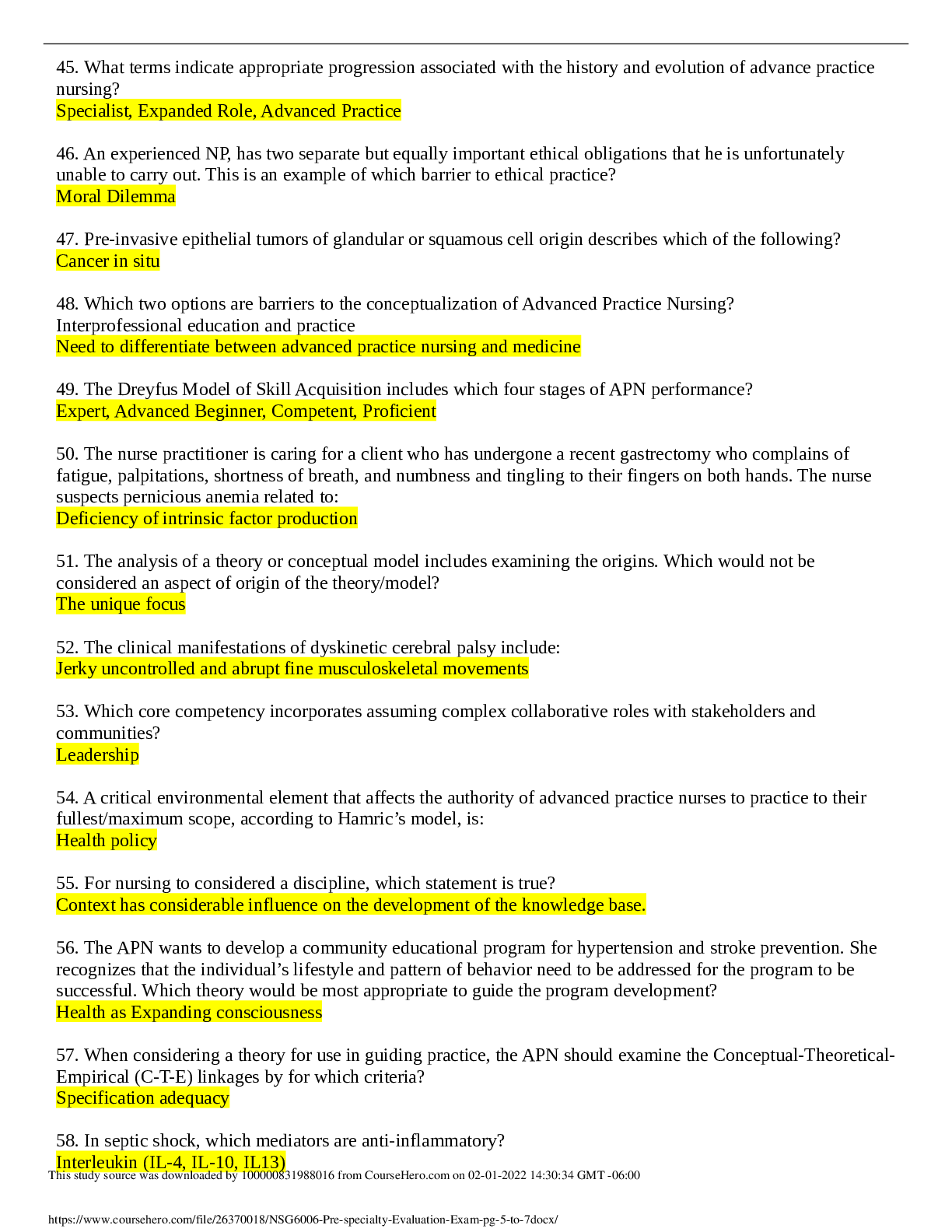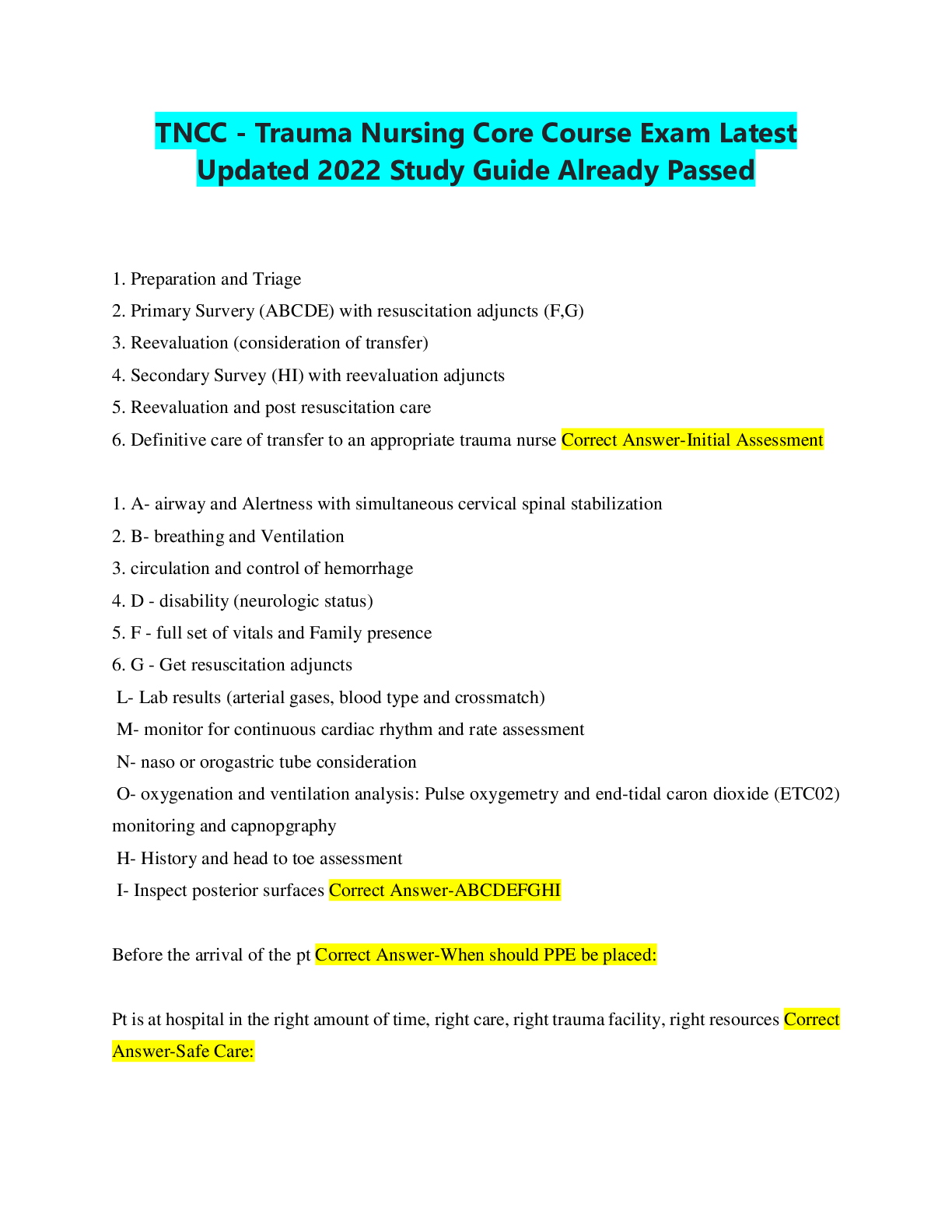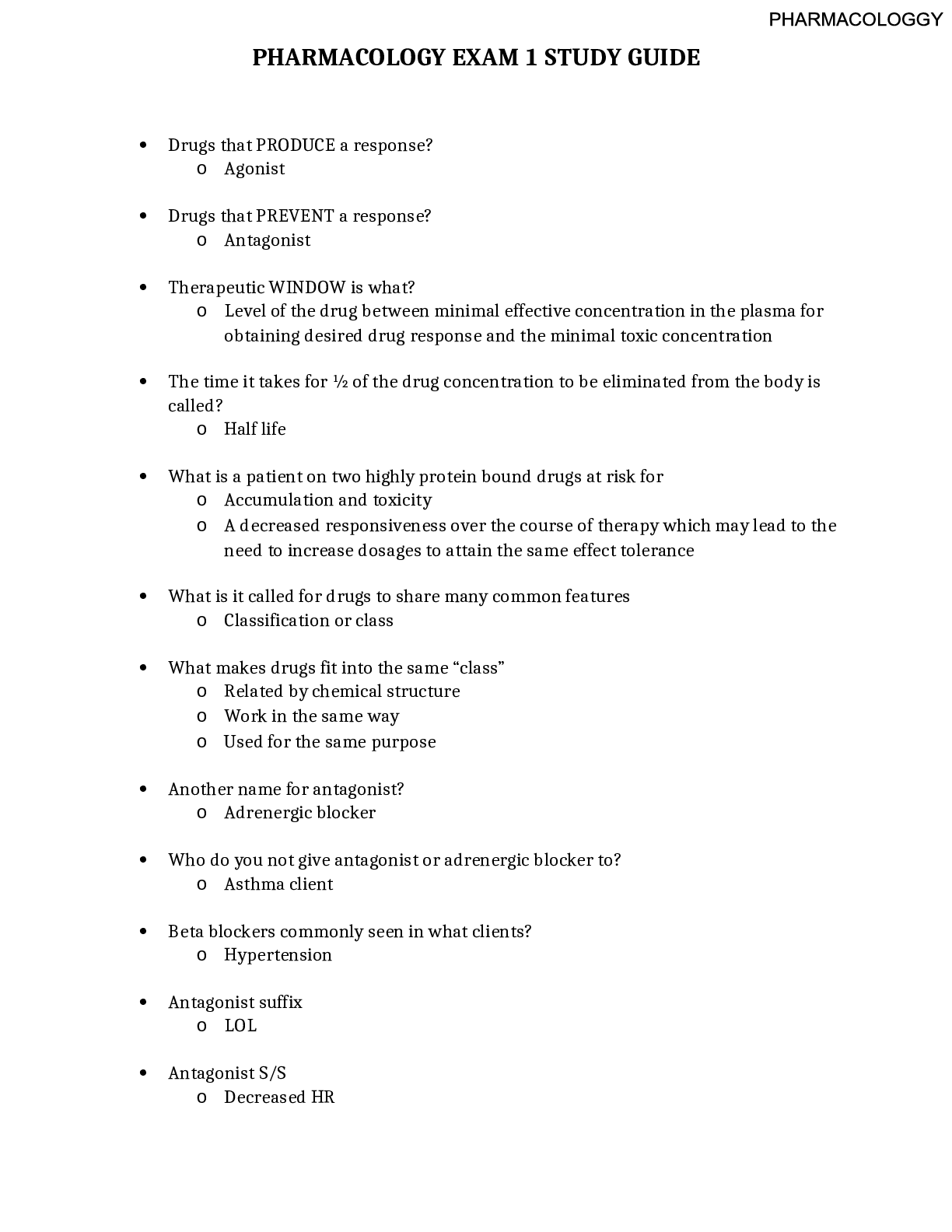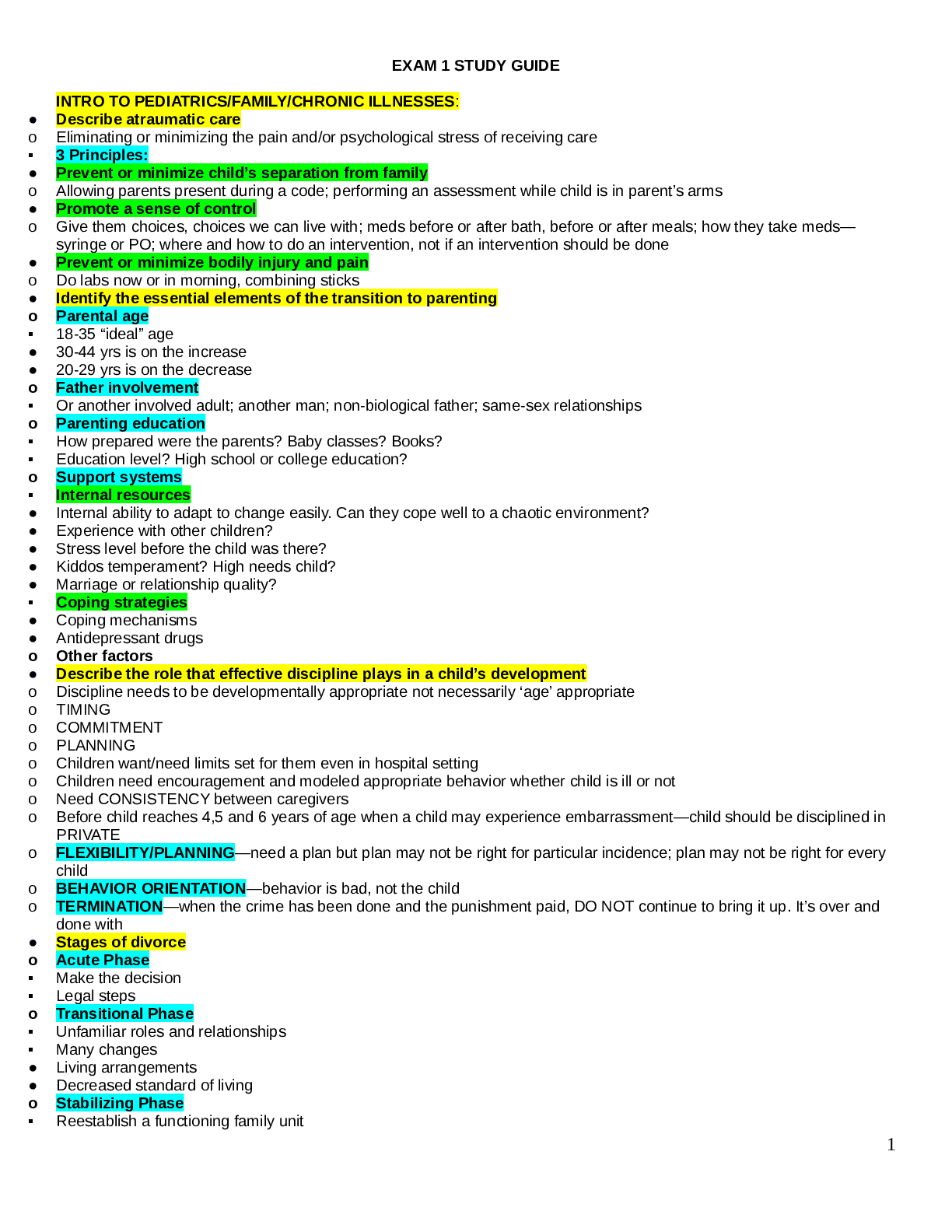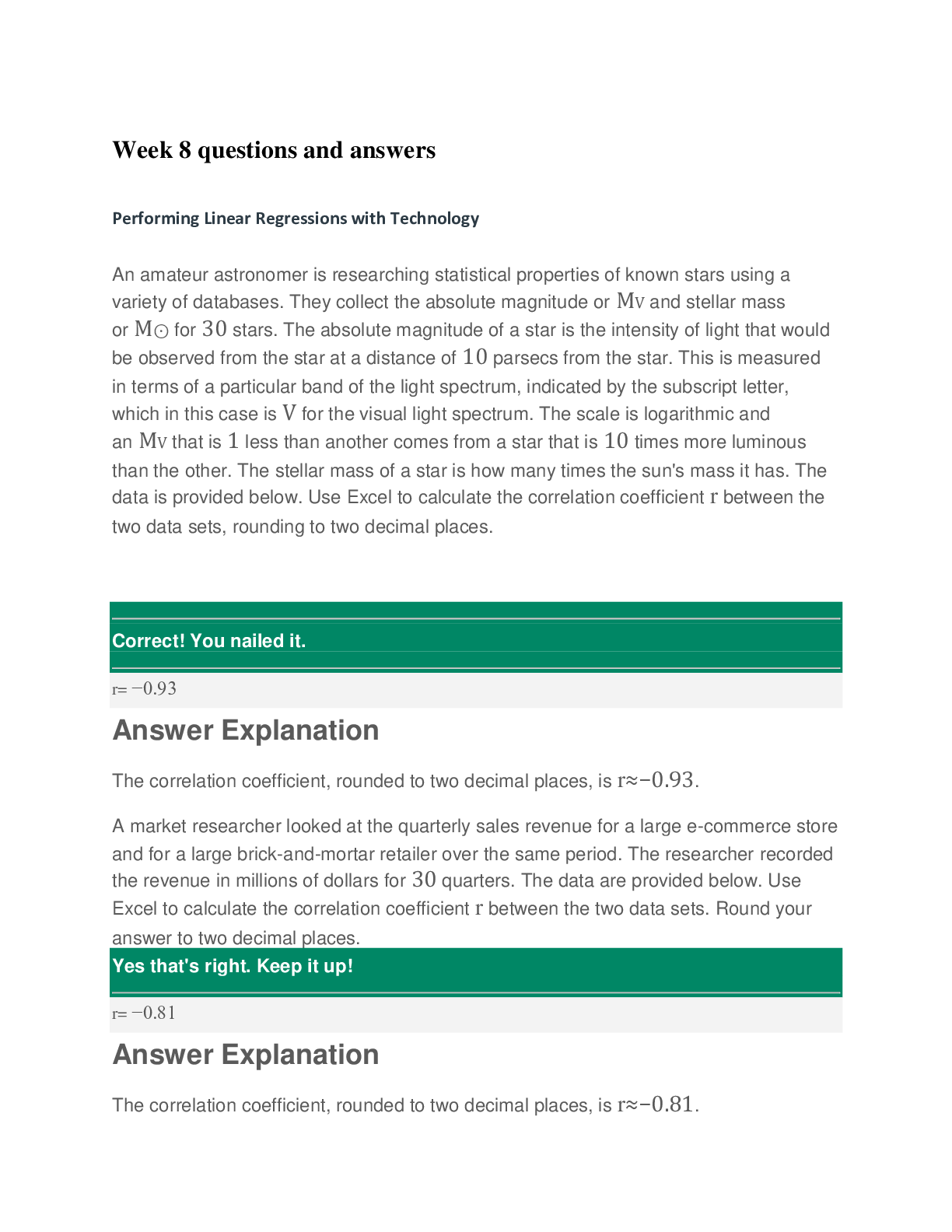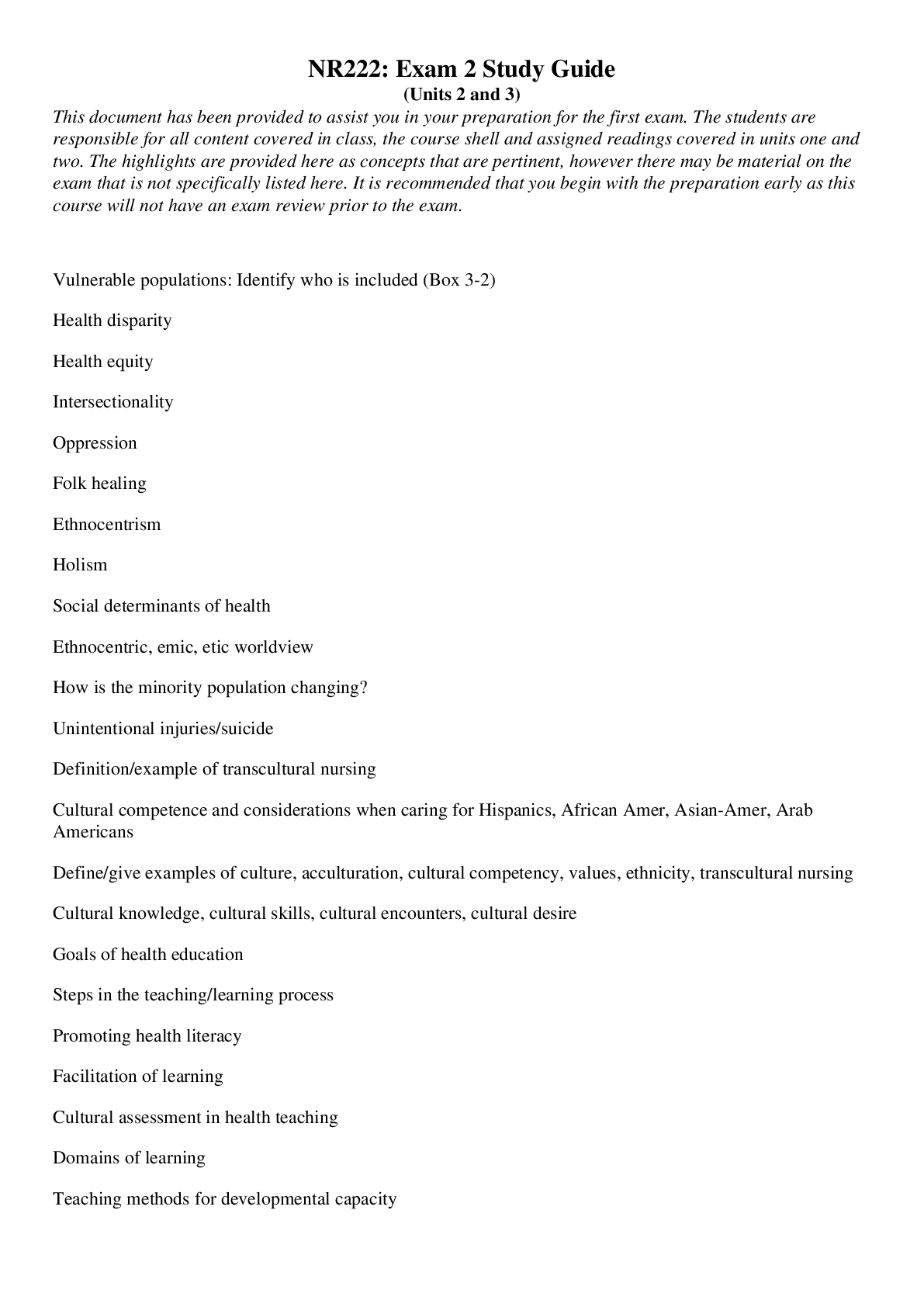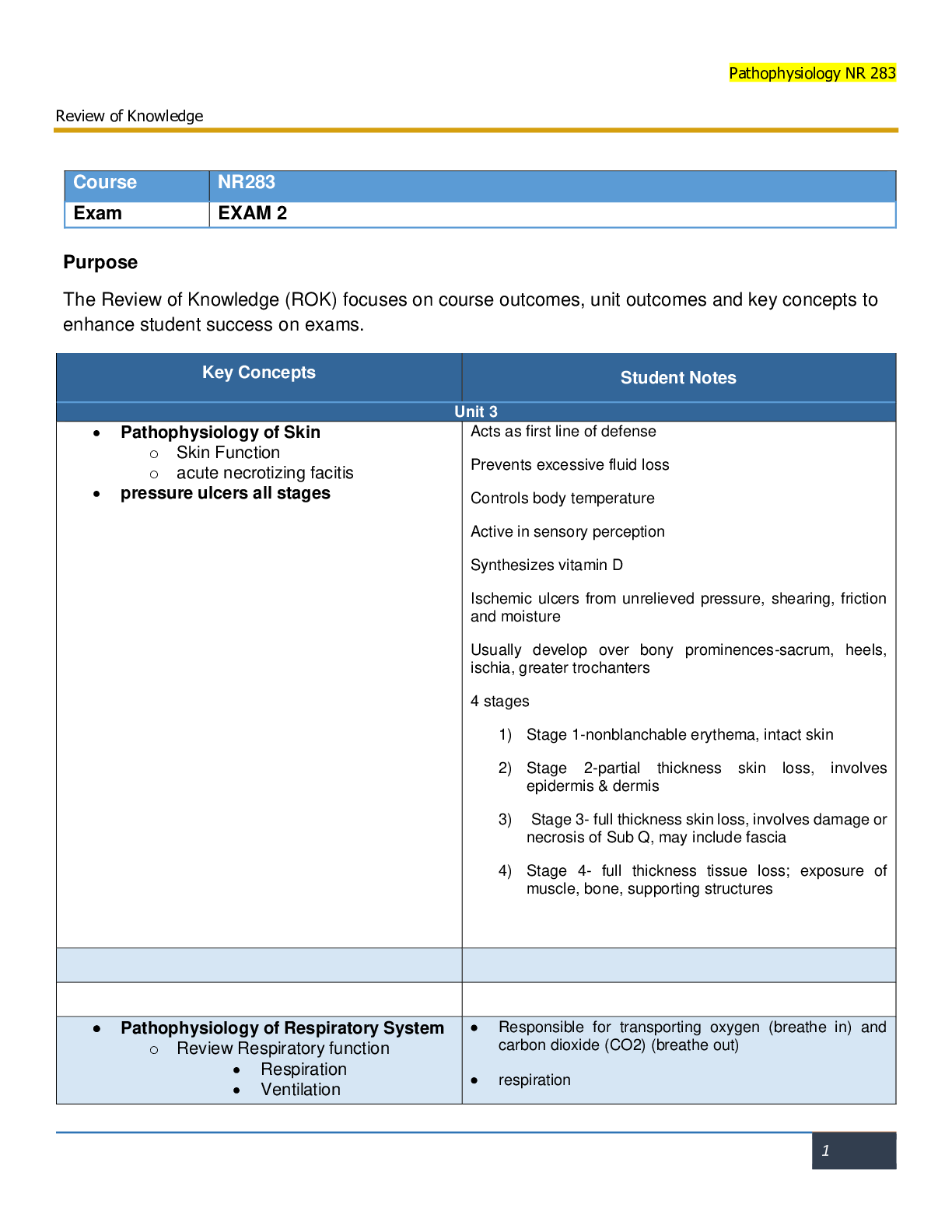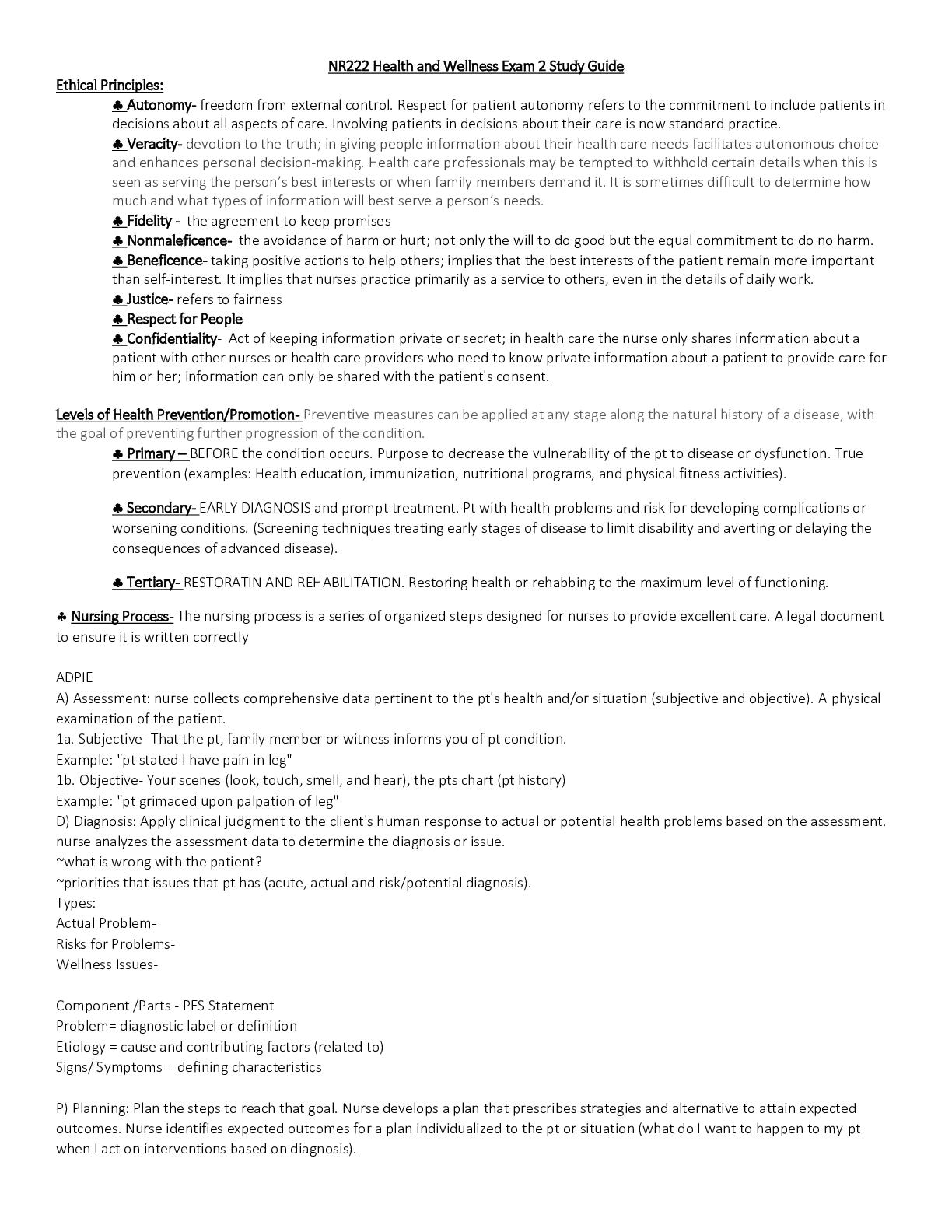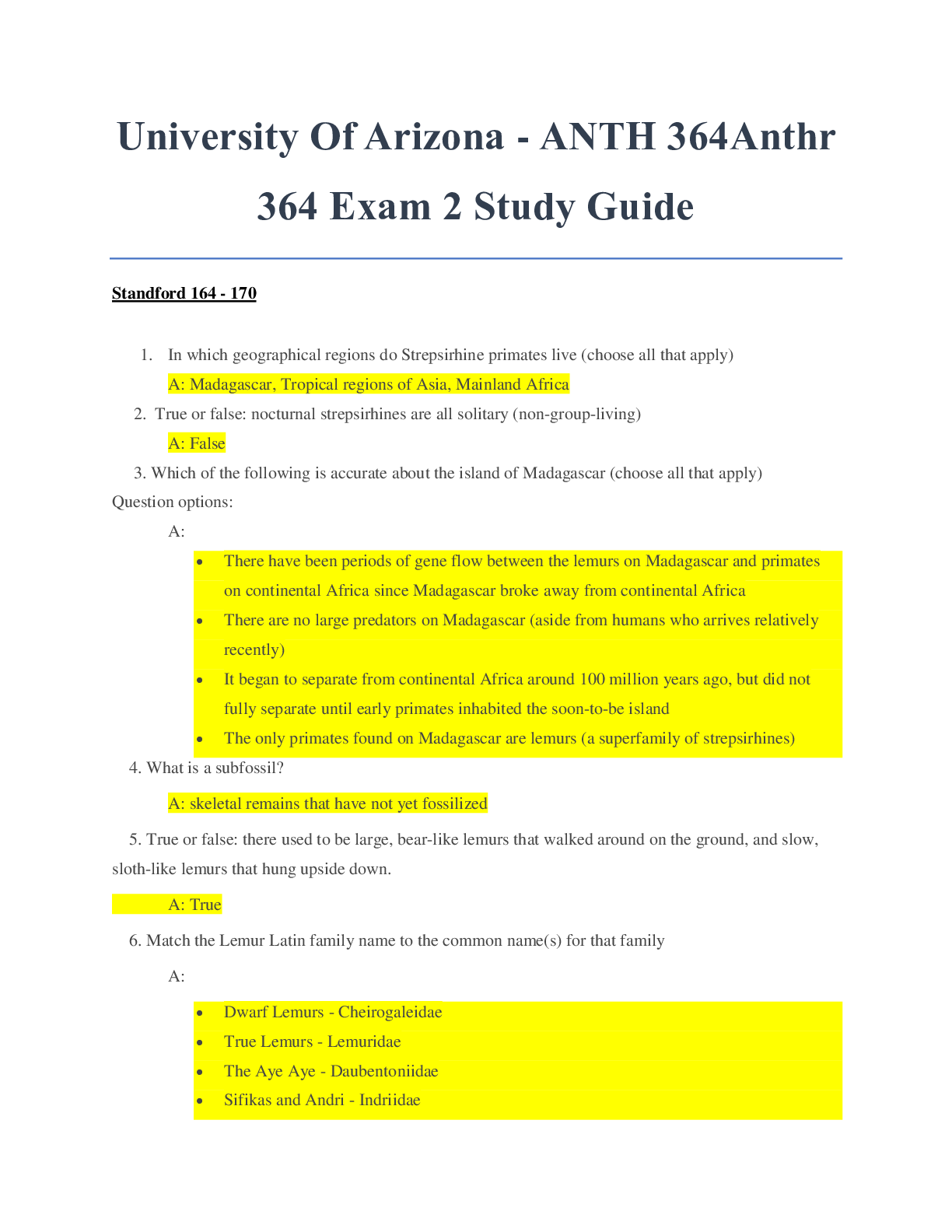*NURSING > STUDY GUIDE > NR 328 Exam 2 Study Guide / NR328 Peds ATI Test (Latest): Pediatric Nursing: NR 328 Pediatric Nursin (All)
NR 328 Exam 2 Study Guide / NR328 Peds ATI Test (Latest): Pediatric Nursing: NR 328 Pediatric Nursing Exam Chamberlain College of Nursing
Document Content and Description Below
Peds Exam 2 Study Guide Fluid & Electrolytes Chapter 29: Signs and symptoms of fluid overload pg. 1056 pg. 949 & 956-957 Generalized edema, pulmonary edema (moist rales & crackles), Hepatomegal... y, slow bounding pulse, weight gain, lethargy, elevated venous pressure, seizures, coma. Lab findings: Decreased serum electrolytes, low urine specific gravity, decreased hematocrit, variable urine volume. Signs and symptoms of fluid deficit pg. 1056 pg. 949 & 951-955 Top 3: #1 Poor skin turgor #2 abnormal respirations= Tachypnea #3 Prolonged capillary refill >2 secs Tachycardia, dry skin & mucous membranes, sunken eyes & fontanels, irritability, lethargy, thirst, weight loss, diminished urine output, and altered level of consciousness, disorientation. Lab findings: High urine specific gravity, increased hematocrit, increased BUN, increased serum osmolality Hypo and hyperkalemia & Foods that contain potassium Pg. 1359 pg. 1271 Hypokalemia: o < 3.5 mEq/L o Abnormal EKG; notched or flattened T waves, decreased ST segment, premature ventricular contractions o Muscle weakness, cramping, stiffness, paralysis, hyporeflexia, hypotension, cardiac arrhythmias, gallop rhythm, tachycardia or bradycardia, ileus, apathy, drowsiness, irritability, fatigue Hyperkalemia: o > 5.5 mEq/L o Variable urine volume o Flat P wave on ECG, peaked T waves, widened QRS complex, increased PR interval o Muscle weakness, flaccid paralysis, twitching, hyperreflexia, bradycardia, ventricular fibrillation and cardiac arrest, oliguria, apnea—respiratory arrest Foods that contain potassium: Foods with thick skin: Oranges, banana, nuts, squash, carrots, broccoli, kale, tomatoes, beans, avocado, fish, mushrooms Signs and symptoms of hypo & hypernatremia pg. 1056 pg. 949-950 Hyponatremia (less than 135 mEq): anorexia, nausea, vomiting, weakness, lethargy, confusion, muscle cramps, twitching, & seizures. Hypernatremia (more than 145 mEq): Thirst, hyperpyrexia (Extremely high fever), sticky mucous membranes, dry mouth, oliguria (diminished urine output) hallucinations, lethargy, irritability, & seizures. Types of dehydration: Isotonic, hypotonic, hypertonic (see Ecollege:DocSharing: Powerpoints: GI dysfunction) Babies= ECF > ICF (75% water) leads to more rapid loss Isotonic Dehydration: This is the primary form of dehydration occurring in children (Na remains normal since H2O loss and electrolyte loss are equal. Leads to shock) H2O loss = electrolyte loss hypovolemic shock. The major loss is from the ECF. Symptoms are related to hypovolemic shock Hypotonic Dehydration: Dehydration occurs when the electrolyte deficit exceeds the water deficit. Water moves from ECF to ICF which further increases the ECF volume loss and leads to shock. (Na level usually less than 130 mEq/L) Electrolyte loss >H2O loss shock & seizures (low sodium) Peds Exam 2 Study Guide Hypertonic Dehydration: Dehydration results from water loss in excess of electrolyte loss and is usually caused by a proportionately larger loss of water or a larger intake of electrolytes. This type of dehydration is the most dangerous and requires much more specific fluid of therapy. (Na level usually greater than 150 mEq/L Causes lethargy, seizures, hyperirritability to stimuli losing fluid from the ICF) H20 loss > electrolyte loss neuro. Nursing care of dehydration: oral & intravenous rehydration, reintroduction of regular diet The major goals in the management of acute dehydration include 1) assessment of fluid and electrolyte imbalance, 2) rehydration 3) maintenance fluid therapy, and 4) reintroduction of an adequate diet. Treat infants and children with acute diarrhea and dehydration first with oral rehydration therapy (ORT). ORT is one of the major worldwide health care advances. It is more effective, safer, less painful, and less costly than IV rehydration. Oral rehydration solutions (ORSs) enhance and promote the reabsorption of sodium and water. These solutions greatly reduce vomiting, volume loss from diarrhea, and the duration of the illness. Rehydration with oral solutions can be used over 4-6hours of mild to moderate dehydration. IV rehydration (Normal saline 20ml/kg; lactated ringers 20ml/kg infuse over 20minutes. You need a doctor’s order to do a bolus) if severe and unable to take by mouth (PO). Reintroduction of regular diet after rehydration. Know the formula for calculating the daily fluid requirements based on kg weight of a child pg.947 1-10kg = 100ml/kg 11-20kg = 1000ml + 50ml/kg for each kg > 10kg > 20kg = 1500ml + 20ml/kg for each kg > 20 kg Cardiovascular concepts Chapter 34: Review VSD, coarctation of the aorta symptoms, expected labs, nursing diagnoses Ventricular Septal Defect (VSD): is an abnormal opening between the right and left ventricles. 20-60% of VSDs close spontaneously (spontaneous closing is more likely to happen during the first year of life in children having small or moderate defects). Signs and symptoms of VSD: murmur, poor feeding and failure to thrive, fast breathing and fatigue & SOB. It is classified under increased pulmonary blood flow (acyanotic defect). Diagnostic tests (9th edition table 34-1 <procedures for cardiac diagnosis> pg 1346 is a good table): Radiologic imaging (chest X-ray), Electrocardiography, Echocardiography, Cardiac catheterization (most invasive), Cardiac magnetic resonance imaging. Coarctation of the aorta symptoms (obstructive defect): is a narrowing of the aorta. When this occurs, your heart must pump harder to force blood through the narrow part of your aorta. Symptoms include: Pale skin, irritability, heavy sweating, difficulty breathing, murmur, a weak or delayed pulse, high blood pressure, and difficulty feeding (failure to thrive). Nursing diagnoses: o Fluid volume excess related to edema secondary to CHF o Impaired gas exchange related pulmonary congestion secondary to increased pulmonary blood flow o Imbalanced nutrition: Less than body requirements related to respiratory distress, feeding difficulties o Interrupted Family Processes related to presence of a child with a life threatening illness o Activity intolerance related to respiratory distress, fatigue o Decreased Cardiac Output related to structural defect, myocardial dysfunction, altered hemodynamics o Ineffective breathing pattern related to pulmonary congestion, decreased cardiac output Peds Exam 2 Study Guide Care of the child with a cardiac defect & prevention of stroke Feeding interventions: o Small frequent feedings with 24 cal formula (more calories, less work) o Neutral environmental temperature o Limit feeds to 30 minutes Position upright to feed, and position on R side after feeding, HOB ↑ 30-45 degrees Monitor for feeding tolerance Consider gavage feedings Make sure the patient is well rested to conserve energy Provide oxygen and make sure they are getting enough perfusion Tet spells in TOF (tetralogy of Fallot) and nursing care of tet spells TOF (cyanotic or decreased pulmonary flow): 4 defects make up this congenital heart defects. 1) A hole in the walls between the two sides of the heart 2) Narrowing (stenosis) of the main artery 3) Abnormal thickening of the right ventricle 4) Abnormality in the position of the main artery. Nursing Care: 1) Place infant in knee-chest position 2) Employ a calm, comforting approach 3) Administer 100% oxygen by face mask 4) Give morphine subcutaneously or through existing intravenous line 5) Begin intravenous fluid replacement and volume expansion, if needed 6) May give propranolol 7) Repeat morphine administration. Blalock Taussig Shunt (may be done as well) o Teaching after surgery includes: 1) Good hand hygiene 2) Conserve energy 3) May need tube feedings 4) Avoid infectious people 5) Digoxin, diuretics, possibly ASA to prevent platelet aggregation 6) Report increased cyanosis post-op, which indicates shunt occlusion 7) Avoid dehydration!! Cardiac catheterization and care and ass [Show More]
Last updated: 2 years ago
Preview 1 out of 19 pages
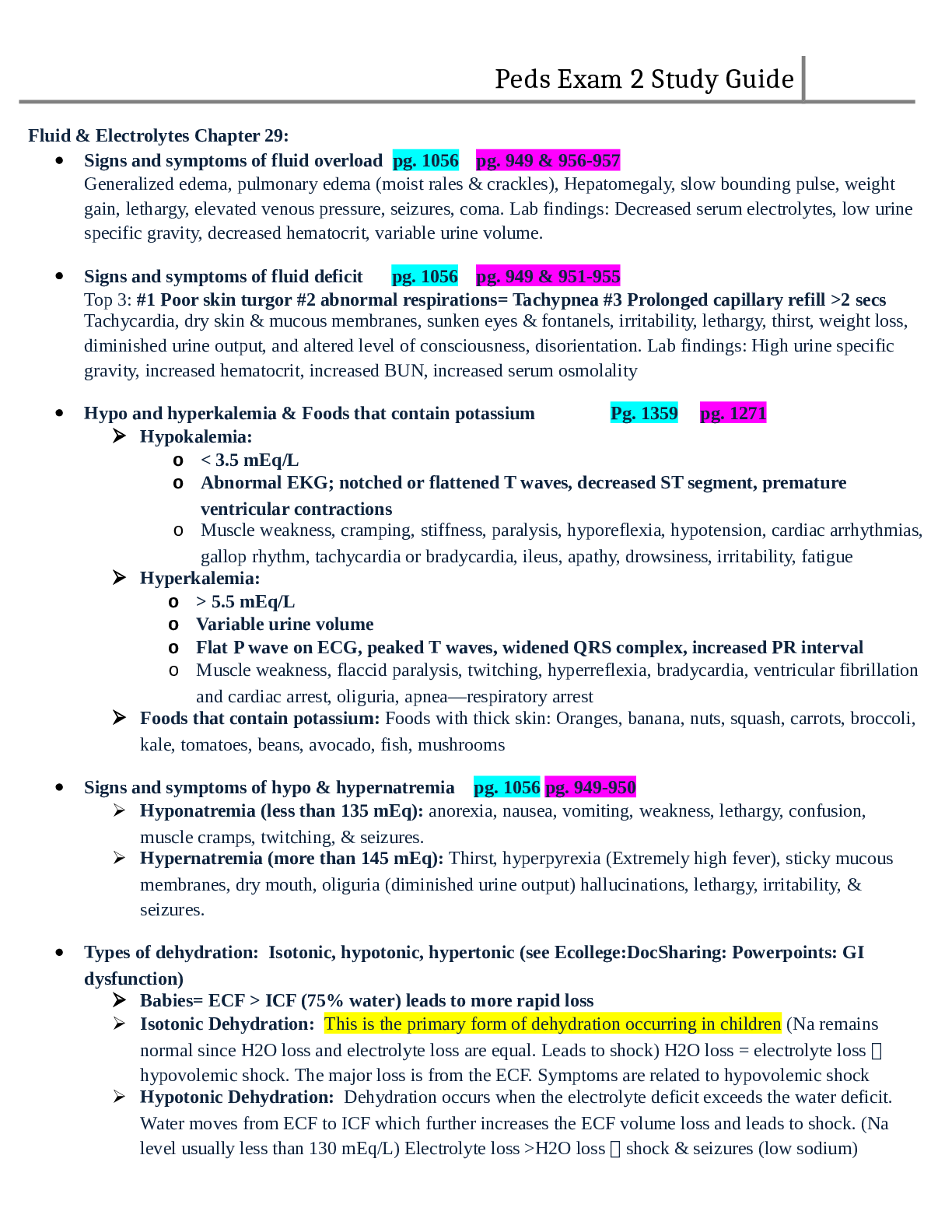
Buy this document to get the full access instantly
Instant Download Access after purchase
Buy NowInstant download
We Accept:

Reviews( 0 )
$10.50
Can't find what you want? Try our AI powered Search
Document information
Connected school, study & course
About the document
Uploaded On
Jun 03, 2022
Number of pages
19
Written in
Additional information
This document has been written for:
Uploaded
Jun 03, 2022
Downloads
0
Views
158




